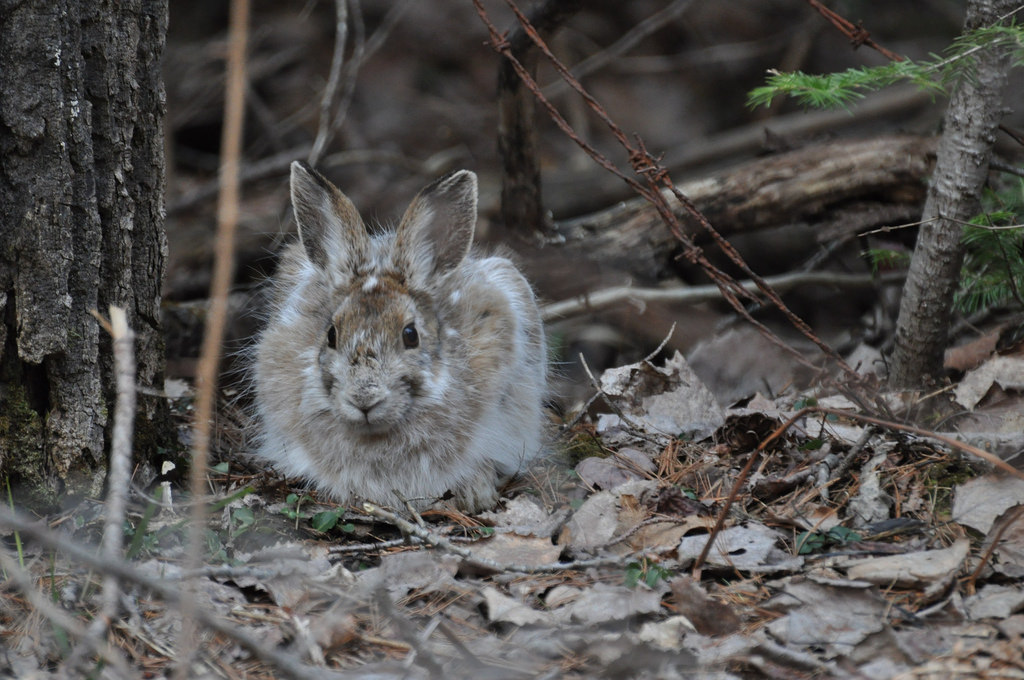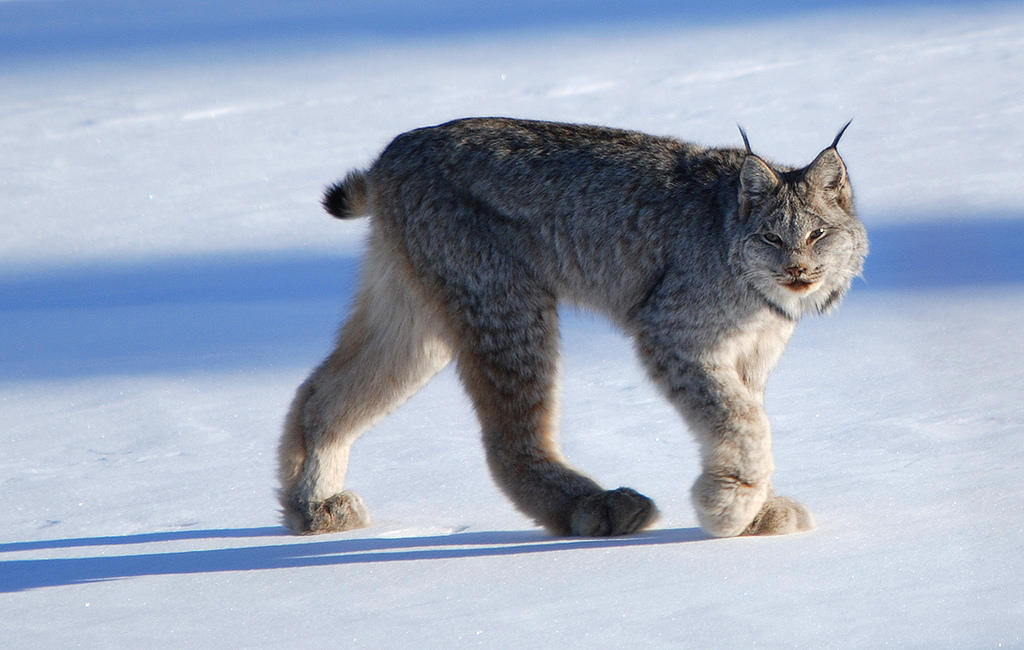Climate Change
4.2 Snowshoe Hare Stands out to Predators as a Result of Climate Change
Lauren E. Younkin
The snowshoe hare, with its unique ability to change the color of its fur to correspond with the seasons, is excellent at concealment from predators. However, climate change’s affect on temperatures has caused the hare’s transformation to be out of sync. Will this phenological mismatch cause a decline in hare populations?

The snowshoe hare (Lepus americanus) is well-known for its remarkable ability to change the color of its fur in correspondence with the seasons.2,3,4,5,7,9,10 With this ability, called phenotypic plasticity,10 the phenotypes of the hare are manipulated to its advantage, disguising it from predators like the Canadian lynx (Lynx canadensis).6,8 The snowshoe hare is not the only species with this trait. Several other creatures that live in the Northern Hemisphere share the molting capability as well, including the Arctic fox and the collared lemming.10 Unfortunately, climate change has negatively affected these animals with color-changing coats. As the winters become shorter due to rising temperatures, there is a period of time (currently about a week) in which the snowshoe hare’s fur does not match with its surroundings.3,9,10 This drastically reduces the effectiveness of the hare’s fur as a defense mechanism, and makes it more visible to predators (Figure 1). This is called a phenological mismatch, and it is a threat to the survival of the species.4
This mismatch is dangerous not only for hares, but for other animals living in the ecosystem, primarily the Canadian lynx.6,8 The snowshoe hare is the main source of prey in the food web of the lynx.6,8 When the hares are scarce, the lynx will turn to other forest animals for food, such as the red squirrel and other rodents.6 The hare and the lynx are connected through a predator-prey relationship, and if one population decreases, the other will likely follow.8 Therefore, as the snowshoe hare’s population decreases because it is more visible to potential threats, the lynx population may also decline as its food source dwindles. The Canadian lynx, an already threatened species,4,5 has had dangerously low population numbers since they started moving farther north as a result of habitat destruction.8 The additional threat of the phenological mismatch of the snowshoe hare could diminish the lynx’s primary food source and further endanger the population.4,5,8
Figure 2. A Snowshoe Hare transitions from an entirely white coat to an entirely brown coat between the seasons of winter and summer. Left photo by D. Gordan E. Robertson 2013, Wikimedia Commons. CC BY-SA 3.0. Right photo by Walter Siegmund, 2013, Wikimedia Commons. CC BY-SA 3.0.
Studies, like those conducted by Zimova, M., et al. (2014) and Mills, L.S., et al. (2013), have aimed to investigate the phenological mismatch of the snowshoe hare’s coat. For over three years, Zimova and Mills placed radio collars on 148 Montana hares, which allowed the researchers to track and monitor the hares’ whereabouts.4,10 Regrettably, due to the short lifespan of snowshoe hares, only seven of the original 148 survived for more than one molting cycle (new hares took the places of the others as they died).4,10 However, the researchers were able to study these creatures in a time period that “spanned among the shortest and longest snow years in the recent past.”4 This provided them with various backdrops needed to test the new plasticity and mismatch of the hares. The team monitored the snowshoe hares in these different environments during the process of their molts, and calculated the percentages of differentiation between their fur, and the amount of snow covering the ground.
Based on their study, Mills and Zimova concluded that the hares were “mismatched when the contrast between [the] coat color and background was at least 60%”.4 As a result of this study, the researchers were able to determine that the starting point of the molts were generally fixed in the spring and fall, and it took around 40 days for the molting process to be completed.4 Throughout the varying conditions each year, the researchers also observed that the molts slightly changed from year to year depending on the current environment and snowfall, suggesting that the snowshoe hares were evolving to match their coats with their surroundings.1,4,10 Unfortunately, scientists do not know what conditions cause this shift in evolution. It may include a number of factors such as the temperature, the sex of the hare, or the level of snowfall.1,4,10 The depth of snow is important to the snowshoe hare. The animal got its name because its feet have adapted to be wide, so it can walk across thick snow.7

Currently, the phenological mismatch concern for the snowshoe hare is not dire. The animals are currently only out of sync for about one week of the year,3,9,10 and Zimova and Mills found that this increases the rate of death for the hare by approximately seven percent.3 This is not a significant increase, but over time, it may diminish the population. The research team has estimated that by the end of the century there will be eight weeks of mismatch, significantly increasing the risk for the snowshoe hare.3 However, the snowshoe hare experiences relatively quick evolution over generations through rapid breeding.1
The decrease in snow cover will only worsen as climate change increases. Luckily the snowshoe hare can adapt quickly to environmental changes.1 This should not be a sole-source solution for the species. Mitigating the effects of climate change will improve the survivability for many species in the northern hemisphere. The continued survival of snowshoe hare should be seen as an opportunity for people to view the costs of climate change on the environment.

References:
- Botero, C.A., et al. (2015). Evolutionary tipping points in the capacity to adapt to environmental change. Proceedings of the National Academy of Sciences of the United States of America, 112(1):184-189.
- Kielland, K., et al. (2010). Demography of snowshoe hares in relation to regional climate variability during a 10-year population cycle in interior Alaska. Canadian Journal of Forest Research, 40(7):1265-1272.
- Marris, E. (2014, July 17). Can Snowshoe Hares Evolve To Cope With Climate Change? National Geographic.
- Mills, L.S., et al. (2013). Camouflage mismatch in seasonal coat color due to decreased snow duration. Proceedings of the National Academy of Sciences of the United States of America, 110(28):11660-11660.
- NPR (Producer). (2013, September 8). Climate Change Leaves Hares Wearing The Wrong Colors.Retrieved January 27, 2016, from http://www.npr.org/2013/09/08/220188619/climate-change-leaves-hares-wearing-the-wrong-colors.
- Stenseth, N.C., et al. (1997). Population regulation in snowshoe hare and Canadian lynx: Asymmetric food web configurations between hare and lynx. Proceedings of the National Academy of Sciences of the United States of America, 94(10):5147-5152.
- U.S. Geological Survey (Producer). (2013, July 9). Can Camouflage Keep up With Climate Change? White Hares on Brown Snowless Backgrounds as a Model to Study Adaptation to Climate Stress.
- Yan, C., et al. (2013). Linking climate change to population cycles of hares and lynx. Global Change Biology, 19(11):3263-3271.
- Zielinski, S. (2016, January 26). Climate Change May Be Deadly For Snowshoe Hares. Science News. Retrieved from https://www.sciencenews.org/blog/wild-things/climate-change-may-be-deadly-snowshoe-hares.
- Zimova, M., et al. (2014). Snowshoe hares display limited phenotypic plasticity to mismatch in seasonal camouflage. Proceedings of the Royal Society B-Biological Sciences, 281(1782).
Figures:
- Becks, Peg. (2011). [Photograph of Snowshoe Hare both brown and white coloring]. Retrieved from FlickrCommons. CC BY 2.0.
- Cephas. (2009). [Range map of snowshoe hare]. Retrieved from Wikimedia Commons. CC BY-SA 3.0.
- Robertson, D. Gordon E. (2013). [Photograph of Snowshoe Hare white morph]. Retrieved from Wikimedia Commons. CC BY-SA 3.0.
- Siegmund, Walter. (2013). [Photograph of Snowshoe Hare in brown coloring]. Retrieved from Wikimedia Commons. CC BY-SA 3.0.
- Williams, Keith. (2010). [Photograph of Canada Lynx]. Retrieved from FlickrCommons. CC BY 2.0.
